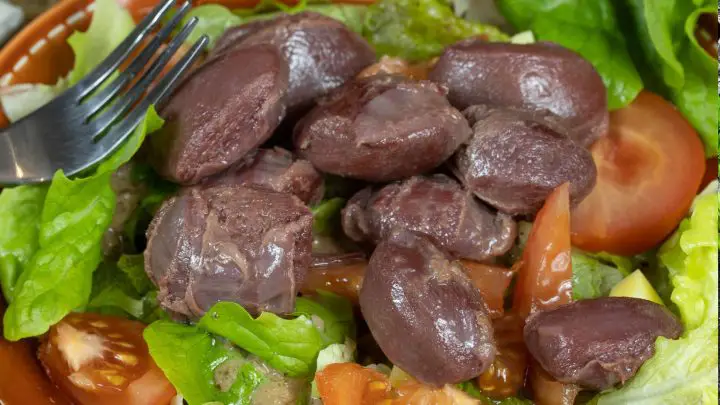How can we make sure that our dogs are getting as many nutrients as possible to ensure a long, happy life? What about chicken hearts for dogs? Can dogs eat chicken hearts? Will they do a dog any good? All this and more today. We will explore the various nutritional benefits of chicken hearts for dogs. We’ll also get into gizzards, with a recipe atop that you can try at home.

Table of Contents
- Chicken Hearts aka Gizzards Are Good For Your Dog!
- How to Serve Chicken Hearts to Dogs
- Gizzards?
- How Often?
- Chicken Hearts for Dogs Recipe
- Last Bark – Chicken Gizzards for Dogs
- FAQs
Chicken Hearts aka Gizzards Are Good For Your Dog!
Indeed, as much as the idea of eating chicken hearts might be off-putting to a human, they are an incredibly rich source of nutrition for a dog.
It is not hard to see how either. Dogs are, after all, just wolves that have been domesticated over hundreds and hundreds of generations. There will, then, be an essentially carnivorous element to any dog. If left to its own devices, a dog might easily eat an entire carcass.
And this is far from being to a dog’s detriment. Chicken hearts are rich in vitamin A, iron, some B vitamins. Also, taurine, one of the more important building blocks of protein. The heart of an animal is inherently a lean protein. The hearts of a chicken or turkey especially contain many essential fatty acids.
Interestingly enough, current medical advice suggests that it is better to serve hearts raw. Antithetical though it may seem, any heat applied either on the stove or during the canning process will decrease the amount of nutrients present. In fact, the canning process itself can affect the taurine in the raw product. It renders it more difficult overall for the pet’s metabolism to process.
Of course, if you are not so fond of watching your pet consume raw body parts – or if, for example, your own dog does not take so well to raw food – then you can prepare chicken hearts for your dog at home.
The beauty of chicken in this regard is just how economical a meat it is, financially and nutritionally speaking. Often, the hearts and other innards of a chicken are kept inside the chicken when purchased. These are more popularly known as gizzards. Being something of an acquired taste, seem aptly tailored for the enjoyment of your canine friend.

How to Serve Chicken Hearts to Dogs
For all the varying nutrients present in chicken hearts, there are even more ways to prepare them for consumption. Just as with normal chicken breast or thigh, you can, for example, fry a chicken heart in some oil until light and golden brown. But this might not be the best for dogs.
Indeed, you can even boil them if that is more your thing. The possibilities are endless, actually, especially when you consider the presence of domestic gadgets and wizardry like food dehydrators. Thanks to the innate carnivorousness of a dog, your own pet will not be able to help but love chicken hearts no matter the form they come in.
The responsibility, however, is also yours to assume. Chicken hearts can work in several ways as a part of a dog’s diet, either as part of their regular eating schedule or as well-deserved treats.
The choice is yours and, thus, should be informed by your own understanding of your dog’s habits and desires.
Even if meted out properly (if you will pardon the pun), there can still be a number of unexpected consequences around the introduction of chicken hearts to a dog’s diet.
Being inherently high in vitamin A, any dog owner introducing chicken hearts to their pet’s diet will need to be ready to face the consequences of an overdose. These are never too serious, of course, though anyone less inclined toward cleaning up runny poop ought to look away now.
This can, though, be a good natural remedy to give a dog suffering from constipation.
This is far from the only thing to consider, however. A dog’s nutritional needs will no doubt vary according to its age, breed, and health more generally.
Therefore, it would be best to consult either your vet or another reputable source before making any significant changes to a dog’s diet like so. Even a bit of research from a reputable source will do the trick.
Gizzards?
Before we go on, perhaps we should be a little clearer about what exactly a gizzard is. The term is used so interchangeably with others that it can be hard to know for sure what is even being discussed.
First things first, chickens do not have teeth. Mind-boggling, I know – this was certainly news to me.
Instead of chewing its food, a chicken will simply peck at the ground and hope for the best. Inevitably, small bits of rock, stone, and other unwanted substances are picked up along with the intended pieces of grain.
These pieces of stone and such are lodged in the gizzard of the animal, a muscular structure found in its digestive system. This structure helps to grind food into bits that are actually digestible. Thus, instead of having teeth in its mouth, a chicken will have teeth in its gizzard, or at least the spiritual equivalent.
Interestingly enough, these gizzards are not just good for nothing. Rather, they are high in protein, minerals like iron and zinc, vitamin B12, as well as glucosamine, the latter of which is incredibly beneficial to a dog’s cartilage and joints.
This same substance is actually used as a treatment for arthritis, administered so as to bolster the sore and stiff joints of those afflicted with the condition.
However, gizzards are not all good. They come with their own health warnings, high as they are in cholesterol, something that both humans and dogs should avoid as much as possible. For this reason, vets recommend that chicken gizzards constitute no more than twenty percent of a dog’s diet, lest their arteries accrue too much cholesterol, clog and welcome an early death.
How often should you take your dog to the vet? Here’s how to tell.

How Often?
A word of advice on the topic of doggy diets that you will not quickly forget. Serve organ meats to your dog only in moderation.
Hearts and gizzards are organ meats, just like livers and kidneys. As with humans, they should only be consumed in moderation. Lest the negative aspects of these foods pile up.
If a dog is regularly active and keeps fit, its diet should consist of around 10% meat from organs. Alternatively, if a dog is extremely active above and beyond the call of duty, its consumption of organ meat can increase to around 15% of its diet.
Special care is to be taken if a dog shows signs of being extremely overweight or flagging in health. In such circumstances, you will not want to give the dog any more than 10% of organ meat in its diet. In fact, you would be far better off giving them even less than this, at least temporarily.
Chicken Hearts for Dogs Recipe
As mentioned above, it is best to serve chicken hearts raw. If, however, you do not fancy watching your dog eat a whole bunch of raw meat (or if your dog does not take as well to raw meat), then you can easily prepare them at home yourself.
Cooking of raw meat will reduce the nutrients present. But cooking it at home yourself will be a better option than relying on the industrial canning process.
If this sounds like it would be your bag, we have a recipe that you can follow at home. Ensure that your dog is getting all that it needs!
- Take a pound of raw gizzards (chopped), a pound of raw chicken (chopped and rid of bones), three large carrots, four hard-boiled eggs (crushed with the shell on), and one cup of water, and add it to a pot.
- Cook on low for two or three hours until everything falls apart easily.
- Add two cups of cooked white rice and another cup of water and continue to cook on low for another thirty minutes.
And it really is as simple as that. This is far from the only recipe of this kind out there. It will work far better if you customize it to your own dog as well,. What do they like, and what do you have lying around the house?
Indeed, you can throw just about anything in as well. Taking as much time to relish in what your dog is eating as what you would eat will ensure an even stronger bond with your dog. You’ll have a greater understanding between the two of you.
Your dog is, after all, a member of your family, so why not treat it like one? Sure, it can’t necessarily have all the fancy things humans have, but it can have the next best thing.
Last Bark – Chicken Gizzards for Dogs
So, there you have it!
Hopefully, you have been inspired to up the ante with your dog’s diet today. Take as much time to relish in it as you would your own diet (or the diet of your family). This only ensures that you and your dog have a stronger bond than ever. You will truly be on a level with them beyond mere mortals.
FAQs
Yes, chicken hearts can be a nutritious and healthy addition to a dog’s diet when fed in moderation.
As a general guideline, you can consider feeding chicken hearts as a treat or snack and aim for the following recommendations:
Small Dogs: For small dogs, such as toy breeds, you can start with 1 to 2 chicken hearts per day.
Medium Dogs: Medium-sized dogs can typically consume 2 to 4 chicken hearts per day.
Large Dogs: Larger breeds may be able to enjoy 4 to 6 chicken hearts per day.
Yes, you can feed raw chicken hearts to dogs as part of a balanced and appropriately prepared diet. Many dogs can tolerate raw organ meats like chicken hearts, and these can provide valuable nutrients when incorporated correctly.




